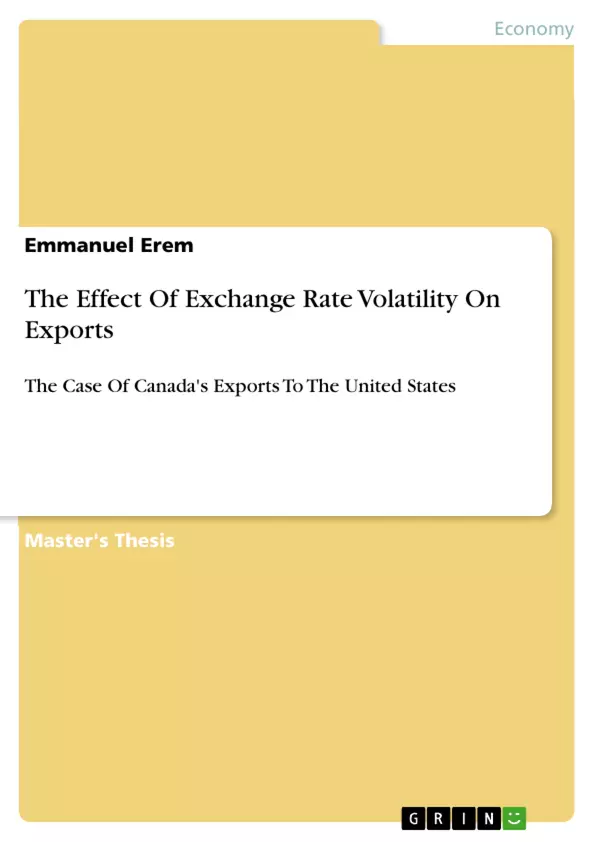The purpose of this thesis is to examine the effect of real exchange rate volatility between the Canadian and US dollars on real exports from Canada to US. The study uses quarterly data from 1960-2017. The GARCH (1, 1) is used to model exchange rate volatility. After finding the variables are non-stationary with no co-integration, a VAR (Vector Auto regression) model is used to investigate the short-run relationship in the variables using Granger causality, impulse response functions and variance decomposition estimates. The results reveal that the effect of exchange rate volatility is of mixed signs with coefficients that are not statistically significant.
The thesis is divided into 7 chapters; chapter 2 gives an overview of important literature and contributions by researchers over the years specifically covering the relationship between exchange rate volatility and trade, exchange rate regimes, exchange rate target zones and inflation targeting. Chapter 3 presents the model and data used, definitions of the variables and the predictions of the model. Chapter 4 gives a theoretical and econometric overview of the unit root and co-integration tests. Chapter 5 gives the data output of the empirical results and discussions of test results. This output is presented using graphs and tables. Chapter 6 is a presentation of the limitations of the model and possible areas of improvement. Lastly, chapter 7 concludes and gives policy recommendations moving forward.
Exchange rates are a key player in any economy that is engaging in international trade. A stable monetary policy system and financial sector play a key role in ensuring the exchange rate stability of the currency of a country. Firms and traders rely on prevailing exchange rates to forecast amounts to produce, import and export; thus are very much affected by the exchange rate volatility. In addition to this, there is a currency conversion cost in international trade. Traders use a number of products in financial markets to hedge against currency fluctuations; these include among others forwards contracts. This is especially true for short-term hedging than long-term hedging.
Inhaltsverzeichnis (Table of Contents)
- Chapter 1: Introduction
- Chapter 2: Literature Review
- 2.1 Relationship between Exchange Rate Volatility and Trade
- 2.2 Effect of Exchange Rate Regimes
- 2.3 Exchange Rate Target Zones
- 2.4 Inflation Targeting and Exchange Rate Volatility
- Chapter 3: The Model and Data
- 3.1 Real Exports
- 3.2 Gross Domestic Product
- 3.3 Real Bilateral Exchange Rate
- 3.4 Volatility
- 3.5 Predictions of the model
- 3.6 Data sources
- Chapter 4: Tests
- 4.1 Unit Root Tests
- 4.2 Co-integration Tests
- Chapter 5: Empirical Results and Discussion
- 5.1 Summary Statistics
- 5.2 GARCH effects in the Real Exchange Rate
- 5.3 GARCH (1, 1) coefficients
- 5.4 Time series graphs
- 5.5 Unit Root Tests
- 5.6 Lag Order Selection
- 5.7 Co-integration Test
- 5.8 The VAR Model
- Chapter 6: Limitations of the study and Improvements
Zielsetzung und Themenschwerpunkte (Objectives and Key Themes)
This thesis investigates the impact of real exchange rate volatility between the Canadian and US dollars on real exports from Canada to the US, using quarterly data from 1960 to 2017. The study employs the GARCH (1, 1) model to analyze exchange rate volatility and the VAR model to examine short-run relationships between the variables, considering Granger causality, impulse response functions, and variance decomposition estimates.
- The impact of exchange rate volatility on exports
- The relationship between exchange rate volatility and trade
- The application of GARCH and VAR models in economic analysis
- The short-run dynamics of exchange rates and exports
- The influence of economic factors on trade patterns
Zusammenfassung der Kapitel (Chapter Summaries)
- Chapter 1: Introduction: Provides an overview of the research topic, its relevance, and the objectives of the thesis. It outlines the methodology and the data used in the study.
- Chapter 2: Literature Review: Examines existing literature on the relationship between exchange rate volatility and trade, including the effects of different exchange rate regimes, target zones, and inflation targeting.
- Chapter 3: The Model and Data: Details the theoretical model used to analyze the data and explains the variables included in the study, such as real exports, gross domestic product, real bilateral exchange rate, and volatility.
- Chapter 4: Tests: Describes the statistical tests applied to the data, including unit root and co-integration tests, to assess the stationarity and long-run relationship between the variables.
- Chapter 5: Empirical Results and Discussion: Presents the findings of the analysis, including summary statistics, GARCH effects, GARCH (1, 1) coefficients, time series graphs, lag order selection, co-integration test results, and the VAR model's outputs. The chapter provides an in-depth discussion of the findings.
- Chapter 6: Limitations of the study and Improvements: Acknowledges limitations of the study and discusses potential areas for improvement in future research.
Schlüsselwörter (Keywords)
The thesis focuses on the relationship between exchange rate volatility and exports, specifically examining the impact of real exchange rate volatility on Canadian exports to the United States. Key concepts include GARCH modeling, VAR models, Granger causality, impulse response functions, variance decomposition, unit root tests, and co-integration tests. The study contributes to the understanding of short-run dynamics in exchange rates and their implications for trade flows.
- Quote paper
- Emmanuel Erem (Author), 2018, The Effect Of Exchange Rate Volatility On Exports, Munich, GRIN Verlag, https://www.grin.com/document/459338



